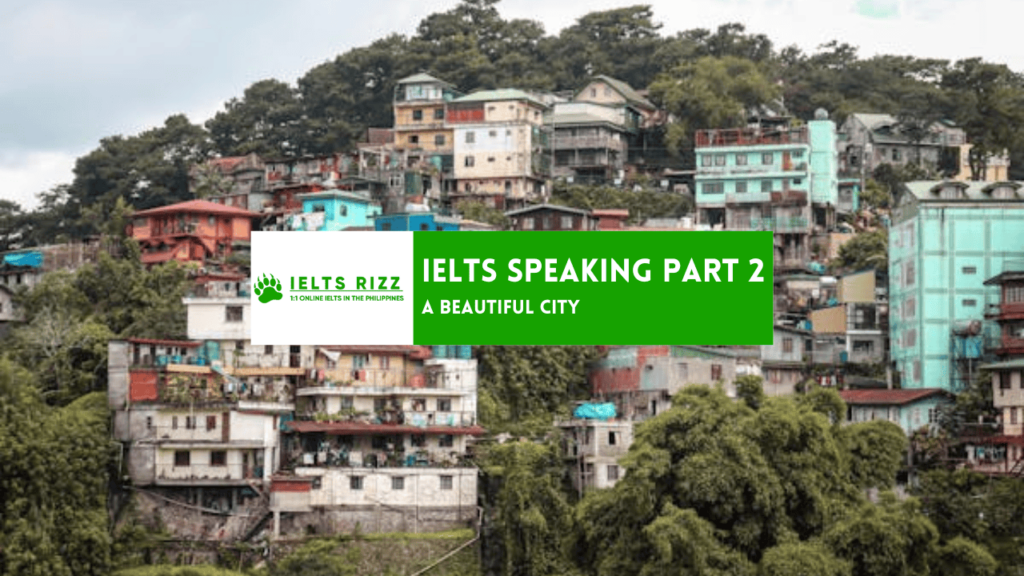
IELTS Speaking Part 2 and 3 : Describe a Beautiful City
IELTS Speaking Part 2 – Describe a Beautiful City
Describe a beautiful city
You should say:
- Where the city is
- How you knew about the city
- What buildings the city has
- What it is famous for
- And explain why you think this city is beautiful
Version 1
Baguio City, situated approximately a 6 to 7-hour drive north of our international airport, entails quite the journey. The road, though paved, tends to get congested due to its popularity as a tourist destination. I remember it being less crowded in my younger years, but as time went by, more people I know have shown interest in visiting. Its appeal lies in its culinary scene, natural beauty, and vibrant nightlife. Additionally, boasting three of the region’s top universities adds to its allure.
Nestled amidst the mountainous terrain, Baguio City’s architecture seamlessly integrates with its surroundings. Buildings are intricately designed to complement the contours of the mountains, often featuring one flat side and another sloped differently than those in flatter regions. The city’s historical significance, rooted in its occupation during World War II, along with its religious landmarks like the prominent Taoist temple, captivates the admiration of visitors.
There’s a plethora of dining options as well, ranging from Chinese, Indian, Middle Eastern, to European cuisine, catering to diverse tastes. The night market is another highlight, sprawling along a road with a variety of goods available. Most visitors flock there for popular items like strawberry jam or purple yam. The shopping experience is equally enticing, with the bustling Session Road offering everything from bargain finds to designer boutiques. This diversity makes Baguio City accessible to people of all financial backgrounds, creating a shared space for everyone.
Beyond its physical attributes, Baguio’s moderate climate appeals to those from colder regions, while its status as a tourist hub ensures a bustling atmosphere throughout the year. Even during quieter times, such as the COVID-19 pandemic, the city has demonstrated resilience, swiftly bouncing back to its lively self once restrictions were eased.
IELTS Speaking Part 3 – Describe a Beautiful City
1. What are the differences between modern towns and modern cities?
The differences between modern towns and modern cities lie in various aspects. Modern cities tend to have a more straightforward and busy atmosphere compared to modern towns. Despite this, people in modern towns are generally friendlier. Additionally, modern cities typically boast better facilities, amenities, sanitation, and waste disposal systems compared to modern towns. In terms of traffic, modern cities usually have more congestion, even though they may have public transportation systems in place.
2. Why do some people like to visit historical sites?
People are attracted to historical sites not only for their historical importance but also for the opportunity to showcase their travels. Visiting historical landmarks allows individuals to display that they have been to specific places, adding to their travel experiences and memories.
3. How can people preserve historic cities and historic buildings?
Preserving historic cities and buildings requires vigilance from everyone. These sites are often at risk of destruction due to natural disasters, erosion, earthquakes, hurricanes, tornadoes, and vandalism. To safeguard them, it’s crucial to prevent vandalism, avoid reaching capacity, and be vigilant against any attempts to destroy them.
4. Is it the government’s responsibility to preserve historic cities and historic buildings?
While it’s everyone’s responsibility to preserve historic cities and buildings, the government holds a significant role due to its authority to impose sanctions, enact laws, and allocate resources through taxes. Local governments should take the lead in preservation efforts, with higher levels of government intervening when necessary.
5. Does historic preservation contradict economic development?
Historic preservation can sometimes contradict economic development, especially regarding zoning laws that restrict building near historical sites. Establishing commercial or residential buildings near these sites can compromise their historical significance, posing a challenge to urbanization efforts in certain areas.
6. What do you think will happen to historic places or buildings in the future? Why?
Eventually, all man-made structures, including historic places and buildings, will face destruction. Preservation efforts aim to delay this inevitability for as long as possible, allowing future generations to appreciate and care for these cultural treasures. However, despite preservation efforts, the eventual decay or destruction of historic sites and buildings is inevitable over time.
Check Placement Test for Speaking
Please visit the website Educatorian to find suggested answers for IELTS speaking questions. Additionally, I recommend checking out Ian’s website for further information.
请访问Educatorian网站,找到雅思口语问题的建议答案。此外,我建议查看伊恩的个人网站以了解更多信息。

Ian Tanpiuco – Virtual Assistant, Educatorian, and IELTS Rizz Tutor. Ian’s goal is to enhance his students’ IELTS scores through a comprehensive curriculum that focuses on understanding rather than mere memorization.
